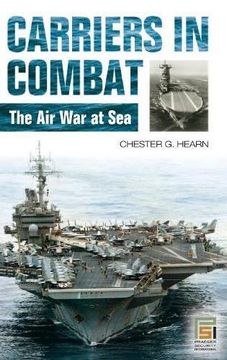Compartir
Carriers in Combat: The air war at sea (en Inglés)
Chester G. Hearn (Autor)
·
Praeger
· Tapa Dura
Carriers in Combat: The air war at sea (en Inglés) - Chester G. Hearn
S/ 346,08
S/ 692,16
Ahorras: S/ 346,08
Elige la lista en la que quieres agregar tu producto o crea una nueva lista
✓ Producto agregado correctamente a la lista de deseos.
Ir a Mis Listas
Origen: Estados Unidos
(Costos de importación incluídos en el precio)
Se enviará desde nuestra bodega entre el
Lunes 10 de Junio y el
Lunes 24 de Junio.
Lo recibirás en cualquier lugar de Perú entre 2 y 5 días hábiles luego del envío.
Reseña del libro "Carriers in Combat: The air war at sea (en Inglés)"
Since World War II, there have been no engagements between carrier air groups, but flattops have been prominent and essential in every war, skirmish, or terrorist act that could be struck from planes at sea. Carriers have political boundaries. They range at will with planes that can be refueled in the air to strike targets thousands of miles inland. From the improvised wooden platforms of the early 20th century to today's nuclear-powered supercarriers, Hearn explores how combat experience of key individuals drove the development, technology, and tactics of carriers in the world's navies.In the early 20th century, during the days of the dreadnaughts, innovators in Europe and North America began to fly contraptions made from wood, canvas, wire, and a small combustion engine. Naval officers soon wondered whether these rickety bi-planes could be launched from the deck of a surface vessel. Trials began from jury-rigged wooden platforms built upon the decks of colliers. The experiments stimulated enough interest for the navies of the world to begin building better aircraft and better aircraft carriers. The novelty of a ship that could carry its own airstrip anywhere on the world's oceans caught fire in the 1920s and helped induce a new arms race. While the rest of the world viewed carriers as defensive weapons, Japan focused on offensive capabilities and produced the finest carrier in the world by 1940. World War II would see the carrier emerge as the greatest surface ship afloat. Since then, no war has been fought without them.
- 0% (0)
- 0% (0)
- 0% (0)
- 0% (0)
- 0% (0)
Todos los libros de nuestro catálogo son Originales.
El libro está escrito en Inglés.
La encuadernación de esta edición es Tapa Dura.
✓ Producto agregado correctamente al carro, Ir a Pagar.

